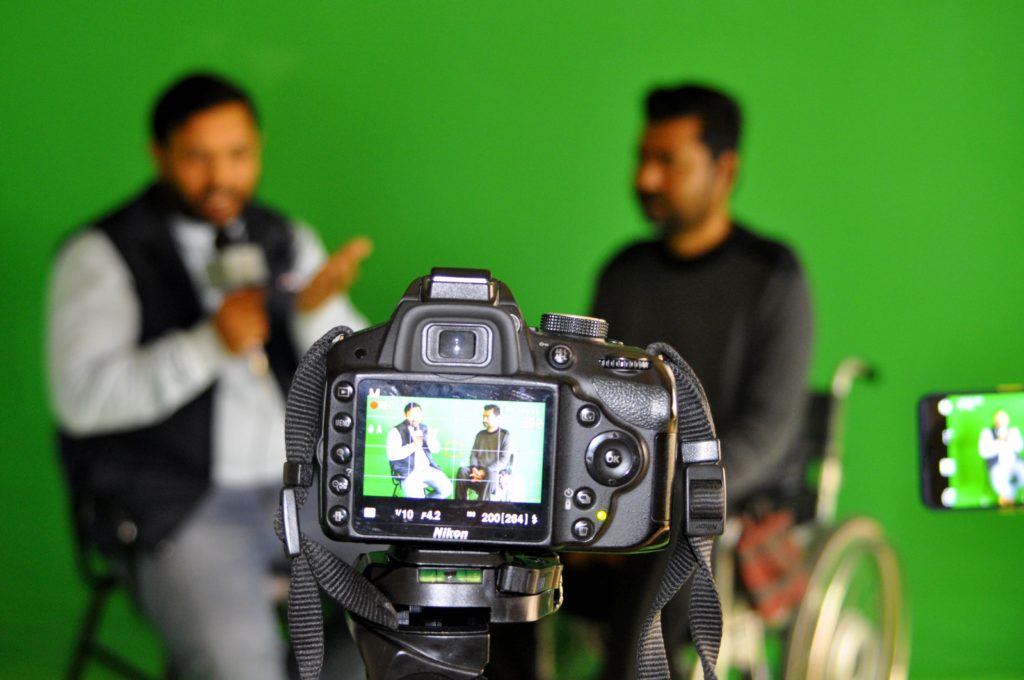Media Interview Bridging: Stay on Track

The media interview has been going along just fine when – wham! – the reporter delivers an off-topic, challenging question about an issue that you hoped to avoid. There’s no turning back without it looking as if you are evading the question.
Is there a way out of this? Yes. It’s called bridging.
You think you are at an impasse, but all you need is a “bridge.” By that, we mean a transition that takes you from the reporter’s question to an answer that works for you. When used successfully, it is a critical part of a spokesperson’s rhetorical toolbox.
The following scenarios show how you can end up in this pickle and how to get out of it.
Media Interview Bridging 101
Scenario 1
The reporter is serving as a tour guide. Too often, interviewees are eager to please the journalist and create a favorable impression. They simply follow along, stopping at the destination points the journalist considers important. That works out fine if those stops are ones the guest also hoped to visit. We have ourselves a problem, however, when important points fail to make the itinerary.
Solution 1
Stay on Message – Effective media guests don’t wait for the reporter (or, tour guide). They use every question (or, stop) to share their most important points with the audience. Every answer is an opportunity to deliver those crucial messages. They use media interview bridging to take the audience from the reporter’s question to their message – nearly every time. Here’s how it works:
Let’s say you are being interviewed about a community art program that you are launching. You have three key points you want to make – it is affordable, accessible, and open to all ages.
Reporter: “I hoped you could talk about how you got started in art.”
Your answer: “I began drawing when I was 3 and painting when I was 6. That’s all thanks to classes that were offered in the town where I grew up.”
Your bridge: “That’s one of the reasons I launched this program.”
You arrive at the other side: “I wanted to provide the same kind of affordable and accessible opportunities I enjoyed as a child. Not everyone will become an artist. However, everyone should have the opportunity to discover art.”
The artist could have digressed into early influences, her hometown, or the type of work she does. Instead, she stayed on message.
Scenario 2
The reporter switches gears and asks an off-topic question. Here’s the problem: Spokespersons need to address the question, but irrelevant subjects take time away from points they want to deliver. Depending on the topic or tone, it also can cause an interview to spin out of control. That disorientation does a number on a spokesperson’s ability to convey information that informs, persuades, and motivates the audience they are trying to reach.
Solution 2
 Get Back on Track – Media guests can expect some “off-road” adventures from time to time, as reporters veer from the beaten path. Savvy guests don’t stay there, however. Instead, through media interview bridging, they guide the reporter back to the main road. Here’s how that works:
Get Back on Track – Media guests can expect some “off-road” adventures from time to time, as reporters veer from the beaten path. Savvy guests don’t stay there, however. Instead, through media interview bridging, they guide the reporter back to the main road. Here’s how that works:
Let’s say you represent an environmental nonprofit working to protect the American crocodile in Florida. There is local concern that a proposal for a conservation area is prioritizing the needs of the crocodiles over the concerns of nearby residents.
Reporter: “Isn’t there inevitably going to be conflict whenever environmentalists propose a new conservation area that impacts local residents?”
Your answer: “There doesn’t have to be.”
Your bridge: “What I hope nearby residents keep in mind is that …
You arrive at the other side: … protecting the American crocodile helps people in the area earn a better living, as the increase in ecotourism will significantly boost local business.”
The spokesperson could have been side-tracked with a philosophical debate about whether conservation areas always rile residents. Instead, he got back on track.
Scenario 3
The reporter asks a guest to speculate. The very word, speculate, should give a spokesperson pause. It’s best not to engage in any theory or conjecture not based on firm evidence. Some questions might be innocuous, such as a request to draw on your expertise to forecast a likely outcome. But others cause damage, particularly if a spokesperson guesses wrong or offers a message that undercuts the image of the organization he or she represents.
Solution 3
Avoid the slip – The speculative question is a slippery slope for a spokesperson. Sure, public representatives can certainly talk about subjects that concern the institutions, companies, agencies, or organizations they work for. However, they want to steer clear of becoming the story. That can happen when a response turns out to be erroneous or is contrary to one of their key institutional messages. Bridging offers safe passage. Here’s how it works:
Let’s say you are a CEO of a technology company that is launching a new version of a popular product. The reporter wants you to speculate on the public’s likely response. You, however, are hesitant to predict the future.
Reporter: “Do you think this new version will become the bestseller in its category?”
Your answer: “There’s no doubt that people are very excited about this product.”
Your bridge: “We’ve seen it with our beta testers, who have responded exuberantly to the improvements that were made to the popular functions of the previous version.”
You arrive at the other side: “We are optimistic that consumers will embrace this latest version, particularly when they see the value this product offers, and want to upgrade to the latest version the first chance they get.”
The CEO couldn’t predict the future. However, it is a safe bet that she made future media interviews easier by avoiding speculative answers that might have come back to haunt her.
Scenario 4
The reporter embeds a false premise into a question. Bias and provocation don’t always drive this practice. Sometimes, a reporter genuinely believes what they say is true, seeing it as conventional wisdom rather than an incorrect proposition. Oh boy! This one is tough. A spokesperson must first right the error before moving on to an answer.
Solution 4
Stay the Course – In their attempts to correct the inaccuracy, media guests could come off as sounding defensive. There’s no need to worry, however, as all it takes is some deft transition to steer the conversation back on course. In this example, a reporter questions a school administrator about test scores and student achievement.
Reporter: “The low scores show test preparation failed to address the areas students needed to master. How are your educators going to adjust their approach for next year’s test?”
Your answer: “I’m not sure the main issue was the test prep itself.”
Your bridge: “Because, what our research shows …
You arrive at the other side: … is that the format of the test was radically different from previous versions. Other school districts also are reporting lower test scores that seem to be stemming from those changes, rather than preparation. We’ve already adjusted our approach by looking at different study options for next year.”
Whether it is a subtle shift, or you find yourself doing some textual heavy lifting, media interview bridging allows you to stay the course. It’s a technique that keeps your responses accurate and on message.
Scenario 5
The reporter asks a confrontational question – a particularly thorny situation. When spokespersons become defensive and linger in that defensive or adversarial attitude, they get into trouble. Not only does it affect the impression they make on the audience, but they miss a genuine chance to offer an answer and deliver a message.
Solution 5
 Stay ahead – We saved one of the more difficult scenarios for last. Reporters want to get to the bottom of the story. In more controversial situations, they may confront a source or interviewee with a confrontational question. Such a question is challenging, but it can be deftly handled – like a difficult move in chess. A potential liability becomes an asset when the response is delivered with grace and authenticity.
Stay ahead – We saved one of the more difficult scenarios for last. Reporters want to get to the bottom of the story. In more controversial situations, they may confront a source or interviewee with a confrontational question. Such a question is challenging, but it can be deftly handled – like a difficult move in chess. A potential liability becomes an asset when the response is delivered with grace and authenticity.
In this example, a line item in the $296 million city budget has piqued the interest of a local newspaper reporter. During an interview, she challenges the town administrator about the cost.
Reporter: “Why are you asking taxpayers to foot a $5,000 expense for ‘party supplies?’ Shouldn’t that money be spent on crucial programs and services?”
Your answer: “This is a wonderful use of city funds.”
Your bridge: “These funds support several celebrations and award ceremonies for community at-risk youth programs.”
You arrive on the other side: “These events are part of our larger efforts to honor and reward volunteers who work with these young people, as well as the young people themselves. Put in the context of the $296 million budget, it’s an investment whose return is hard to beat.”
The more confrontational the question, the more difficult the response. However, nearly every question is answerable. By staying ahead of it, you can diffuse the drama and deliver a meaningful message.
Effective media tool
Learning how to transition from tough questions to meaningful answers is a learned skill. For the critics who see media interview bridging as dodge, it isn’t. In all the scenarios, the interviewer received a direct response and acknowledgment of the question. There was no ducking of the issues.
These techniques are not meant to provide tools to evade questions. Media interview bridging is a tool that you can use to better transition out of sticky situations and deliver meaningful messages to audiences that matter the most to you.
Bridging is not the answer for every answer. However, keep it in your proverbial back pocket for when you need it.
Real-life application
Here’s a real-life example of successful bridging. Several years ago, Rachel Parent, then 14, appeared on a news program in her home country of Canada. She spoke about the organization she founded, “The Kids Right To Know.” The group campaigns for mandatory labeling of foods containing genetically modified organisms.
She answered the tough questions, stayed on message, and helped to persuade some skeptical viewers to her cause.


